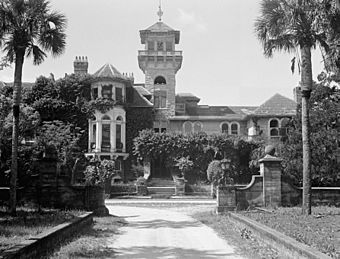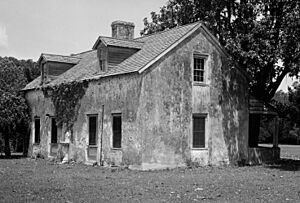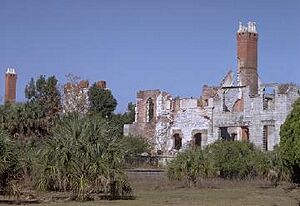Dungeness (Cumberland Island, Georgia) facts for kids
Quick facts for kids |
|
|
Dungeness Historic District
|
|

Dungeness in 1958
|
|
| Lua error in Module:Location_map at line 420: attempt to index field 'wikibase' (a nil value). | |
| Nearest city | St. Marys, Georgia |
|---|---|
| Architect | Multiple |
| Architectural style | Queen Anne, Shingle Style |
| MPS | Cumberland Island National Seashore MRA |
| NRHP reference No. | 84000920 |
| Added to NRHP | February 13, 1984 |
Dungeness is a famous ruined mansion on Cumberland Island, Georgia. It is part of a special historic area. This place was once home to several important American families.
Contents
The First Dungeness
The story of Dungeness began in 1736. James Oglethorpe, who founded the colony of Georgia, built a hunting lodge here. He named it "Dungeness" after a place in England.
The Greene Family's Home
Later, a hero from the American Revolutionary War, Nathanael Greene, became involved with the island. He received about 11,000 acres (45 square kilometers) of land on Cumberland Island. In 1803, his wife, Catharine Littlefield Greene, built a new Dungeness. This was a large, four-story mansion. It was built using a special type of concrete called tabby. The mansion was built on top of an ancient Timucuan Native American shell mound.
During the War of 1812, British soldiers took over Cumberland Island. They used the Dungeness mansion as their headquarters.
A Revolutionary War Hero's Last Days
In 1818, Henry Lee III, known as “Light-Horse Harry” Lee, stayed at Dungeness. He was a brave cavalry commander during the Revolutionary War. He was also the father of Robert E. Lee. Henry Lee lived at Dungeness until he passed away on March 25, 1818. Nathanael Greene's daughter, Louisa, cared for him. He was buried in a nearby cemetery with full military honors.
Abandoned and Burned
The Dungeness mansion was left empty during the American Civil War. Sadly, it was destroyed by fire in 1866.
The Carnegie Family's Grand Estate
In the 1880s, the property was bought by Thomas M. Carnegie. He was the brother of the famous industrialist Andrew Carnegie. Thomas Carnegie started building a brand new mansion on the same spot.
This new Dungeness was a huge Queen Anne style mansion with 59 rooms. It also had beautiful grounds. Thomas Carnegie passed away in 1886, but the mansion was finished after his death. His wife, Lucy Carnegie, continued to live at Dungeness. She also built other large homes on the island for her children. These included Greyfield, Plum Orchard, and Stafford Plantation. By this time, the Carnegie family owned most of Cumberland Island.
Dungeness Today
The Carnegie family moved out of Dungeness in 1925. In 1959, the Dungeness mansion was again destroyed by fire. The cause of the fire is believed to have been arson.
Today, the impressive ruins of Dungeness are protected. The National Park Service takes care of them. They are part of the Cumberland Island National Seashore. The Park Service acquired the ruins in 1972.
The main house ruins are just one part of the larger historic area. This area also includes old servant's quarters, utility buildings, laundries, and water storage tanks called cisterns. All these buildings were part of a carefully planned estate. One of the most important buildings still standing is the Tabby House, also known as the Nathanael Greene Cottage. This building dates back to when the Greene family lived there.



